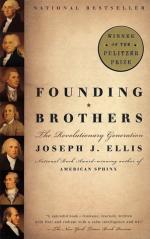
|
| Name: _________________________ | Period: ___________________ |
This test consists of 15 multiple choice questions and 5 short answer questions.
Multiple Choice Questions
1. How many books did Thomas Jefferson publish?
(a) One.
(b) Thirty-six.
(c) Hundreds.
(d) Fifteen.
2. Where did John Adams go to college?
(a) Yale.
(b) MIT.
(c) Harvard.
(d) Brown.
3. Who collaborated with George Washington on his Farewell Address?
(a) Abigail Adams and Martha Washington.
(b) Thomas Jefferson and John Adams.
(c) Alexander Hamilton and Aaron Burr.
(d) Alexander Hamilton and James Madison.
4. Who urged General Washington to free all the slaves at the end of the Revolutionary War?
(a) Jefferson.
(b) The State of Georgia.
(c) Lafayette.
(d) Madison.
5. How long was it before Jefferson and Adams spoke again after Jefferson assumed the presidency?
(a) 30 years.
(b) 20 years.
(c) 12 years.
(d) 2 years.
6. Who were the most popular leaders in the country at that time?
(a) George Washington, Benjamin Franklin, John Adams, Thomas Jefferson.
(b) George Washington, Merriweather Lewis, George Clark and John Adams.
(c) Benjamin Franklin, Benjamin Rush, Thomas Paine and John Paul Jones.
(d) Abigail Adams, John Adams, Thomas Paine and Patrick Henry.
7. Which state, at the time of the debate, had the largest free-black population?
(a) Virginia.
(b) Georgia.
(c) New York.
(d) South Carolina.
8. How was the American republic viewed by the English and French governments at this time?
(a) A major danger to their way of life.
(b) An equal and respected country.
(c) The most important country in the world.
(d) Minor distraction.
9. What was the subject of the petitions to the House of Representatives that caused so much controversy on February 11, 1790?
(a) Revoking the women's right to vote.
(b) Declaring December 25 the official date of Christmas.
(c) Declaring November 25 the official date to celebrate Thanksgiving.
(d) Ending the African slave trade in the USA.
10. To Jefferson, what was the only legitimate form of government?
(a) Monarchy.
(b) Democracy.
(c) Self government.
(d) Communism.
11. When did Washington write his Farewell Address?
(a) May of 1800.
(b) December 1799.
(c) September of 1796.
(d) July of 1776.
12. How did the public obtain the Farewell Address?
(a) It was in the Congressional Record.
(b) It was sent out in the mail to all residents.
(c) It was on the radio.
(d) It was published in all newspapers.
13. What was Washington's attitude towards America's involvement in European conflict?
(a) He recommended America always take the side of the English.
(b) He recommended America always take the side of the French.
(c) He recommended neutrality.
(d) He did not address this problem at any point in his career.
14. What instruction did John give his wife Abigail when he was sworn in as president?
(a) To stop writing him so often.
(b) To leave the farm in Quincy and be at his side for assistance and support.
(c) To make the children move away from the farm.
(d) To purchase more slaves to assist with the farm.
15. What did George Washington do to quell the Whiskey Rebellion?
(a) He paid the ransom.
(b) He sent Thomas Jefferson to negotiate.
(c) He sent the militia to Pennsylvania.
(d) He wrote a letter to the Philadelphia newspaper.
Short Answer Questions
1. Are the terms "slavery", "slaves", or "Negroes" used in the Constitution of the United States?
2. What was the main qualification for a candidate to replace George Washington as the leader of the country?
3. What was one of the concerns shared by pro-slavery and abolitionist factions?
4. Which state, at the time of the debate, had the largest slave population?
5. Where was John Adams born?
|
This section contains 594 words (approx. 2 pages at 300 words per page) |

|




